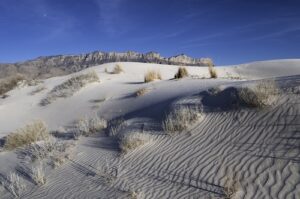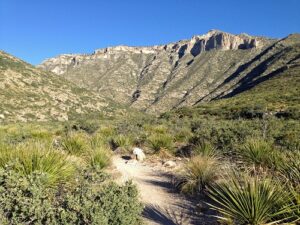With people desperate to get outside, national parks around the country have been flooded with more visitors than ever before. However, Guadalupe Mountains National Park, located 50 miles southwest of the TDS community of Carlsbad, New Mexico, remains a hidden gem, perfect for those who prefer more secluded hikes.
The park is just over the New Mexico border in Salt Flat, Texas, and contains the four highest peaks in the entire state. Guests can camp, stargaze, hike, explore history, and observe wildlife within the serene forests, deserts, refreshing oases, extensive salt dunes, and more. With so much to see and explore, this is a park you’ll want to visit more than once. It is conveniently split up into five regions, each offering unique experiences.
Pine Springs: Pine Springs is the main region of the park with a visitor center, the largest campground, and numerous trails connecting to other regions of the park. For the longest and most challenging hikes in the park, this is the place to start. The main trail, Guadalupe Peak Trail, takes hikers 8.4 miles out and 3,000 feet up to the “top of Texas.” The Pine Springs area also provides access to Williams Ranch for guests wanting to take a long, rocky drive to a secluded area of the park.
 Salt Basin Dunes: The bright-white Gypsum sand dunes stretch across nearly 2,000 acres on the west side of the park. It’s a dramatic contrast with the rest of the forested and vegetated trails in the park. A short trail takes hikers around the northern edge of the dunes for excellent views of the sweeping, sunbaked slopes.
Salt Basin Dunes: The bright-white Gypsum sand dunes stretch across nearly 2,000 acres on the west side of the park. It’s a dramatic contrast with the rest of the forested and vegetated trails in the park. A short trail takes hikers around the northern edge of the dunes for excellent views of the sweeping, sunbaked slopes.
Frijole Ranch: Frijole Ranch is a peaceful oasis in what used to be an early ranching community. It is located 1.5 miles northeast of the Pine Springs Visitor Center, and once there, visitors have much to explore. The Frijole Ranch History Museum illustrates the history of the Guadalupe Mountains, and a nearby schoolhouse and spring house provide insight into the Native American community that once dwelled there. A 2.3-mile hike takes travelers to Smith Spring, a shaded oasis with an abundance of vegetation. A shorter, 0.2-mile hike around the back of the Frijole Ranch History Museum takes you to Manzanita Spring, a desert watering hole that is one of the best areas in the park for spotting wildlife.
 McKittrick Canyon: Described as the “most beautiful spot in Texas,” McKittrick Canyon is one of the more trafficked areas of Guadalupe Mountains National Park, especially in the fall. In late October and early November, the red, yellow, and brown fall foliage contrasts beautifully with the dry Chihuahuan desert. Throughout the year, hikers are surrounded by steep canyon walls, century plants, and prickly cacti. A short hike takes visitors to the historic Pratt Cabin, and a variety of other trails lead through the Permian Reef, exposed caves, and stunning landscapes.
McKittrick Canyon: Described as the “most beautiful spot in Texas,” McKittrick Canyon is one of the more trafficked areas of Guadalupe Mountains National Park, especially in the fall. In late October and early November, the red, yellow, and brown fall foliage contrasts beautifully with the dry Chihuahuan desert. Throughout the year, hikers are surrounded by steep canyon walls, century plants, and prickly cacti. A short hike takes visitors to the historic Pratt Cabin, and a variety of other trails lead through the Permian Reef, exposed caves, and stunning landscapes.
Dog Canyon: Located at the north end of the park, this area is far from civilization. The forested canyon stands at an elevation of 6,300 feet, nestled within steep cliff walls. With a small campground and three trails ranging in length and elevation gain, this is the ideal setting for those wanting to get away and enjoy solitude in nature.
Beginning Sept. 30, 2021, visitors will be able to book camping and RV reservations online at www.Recreation.Gov. Previously, campers would book an open campsite in person on a first come first served basis, but they will need to do it online in the future. Overnight reservations for tent camping and RV stays can now be made up to six months in advance.
By Hannah Drewieck, TDS Communications Intern

No comments yet.